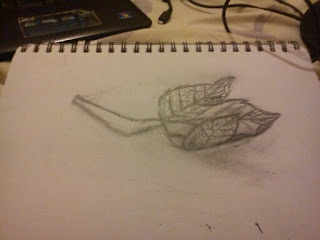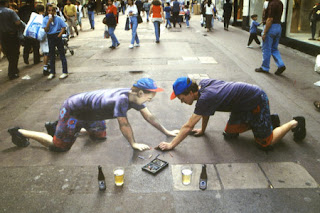My attempts at representing illusion in drawing through anamorphic distortion.
And anamorphic distortion is when an image is drawn in a 'stretched-out' way so when viewed from a specific angle it seems 3 dimensional. This effect is usually achieved when the image is viewed through a camera lense due to eliminating any peripheral vision. The purpose of this kind of drawing is to make it look as if the image is going into or sitting on top of the page.
And anamorphic distortion is when an image is drawn in a 'stretched-out' way so when viewed from a specific angle it seems 3 dimensional. This effect is usually achieved when the image is viewed through a camera lense due to eliminating any peripheral vision. The purpose of this kind of drawing is to make it look as if the image is going into or sitting on top of the page.
This was my first attempt at creating an anamorphic drawing. I was quite pleased with the initial results as I managed to create the effect I wanted, however I needed to hone my ability to represent form and shape as well as the desired effect.

 This was my second attempt at representing the same object. Because I knew how to create the anamorphic distortion I tried to focus on shape and form, which seemed to have been more successful in this trial. Also, I have been more successful in representing the shadow projected from the object, which is important in creating an anamorphic illusion.
This was my second attempt at representing the same object. Because I knew how to create the anamorphic distortion I tried to focus on shape and form, which seemed to have been more successful in this trial. Also, I have been more successful in representing the shadow projected from the object, which is important in creating an anamorphic illusion.
I derived this style of drawing from street artist Julian Beever who often does Trompe Loeil and anamorphic chalk drawings on pavements around the world, some of which have been kept permanent. Beever, like Hoogstraten, had an eye for the illusion of scale and how this may affect the viewer's perception.
Teoh Yi Chie writes "You know your eyes are playing tricks on you but you can't really figure out what's happening". So it seems as though the artist is distorting the environment which is almost a platonic concept as the artists uses false projections that give the impression of reality when it may not be the case.
(source(s): http://julianbeever.net/index.php?option=com_content&view=article&id=1&Itemid=1 book: Pavement Chalk Artist, http://www.parkablogs.com/content/book-review-pavement-chalk-artist-three-dimensional-drawings-of-julian-beever)


No comments:
Post a Comment